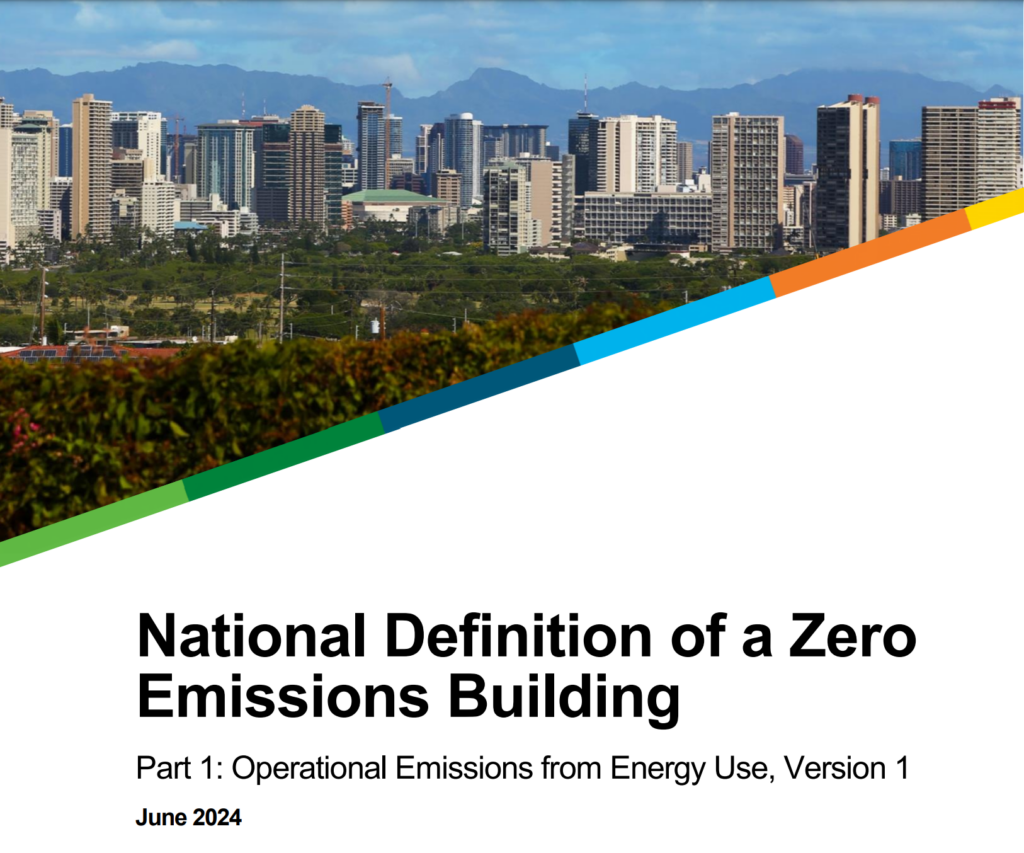
Having a zero-emission home is important to save money and improve comfort and health while reducing your impact on the environment. Until now, there has been no concise definition of what this means in the housing sector. Now we are excited to share with you that the US Department of Energy (DOE) has released a national definition of zero-emissions buildings. The definition includes energy efficiency, electrification, and onsite or offsite renewables through Renewable Energy Credits (RECS). This definition is part one of a two-part definition, with part two focusing on embodied or upfront carbon. This definition works best for new and existing commercial buildings and may apply to newly constructed multifamily and single-family buildings. There are clear and viable strategies for those building types, and GHI will release further guidance and training on those strategies for residential units soon. There are strategies for existing homes with a year of accurate utility data, but they must be clarified. However, this standard requires that existing single-family homes have access to utility data.
During the public comment period, GHI urged the Department of Energy (DOE) to adopt a Home Energy Score of 10 as a baseline for existing homes for this definition. We have provided some clarity on this determination below, and GHI noted that single-family homes can now use the EPA Portfolio Manager Program (ESPM) to help determine how efficient your home is. GHI recently scored homes using the ESPM tool; we entered monthly energy usage, solar power consumed on-site, solar power sent to the grid, and electric car usage. The DOE definition for existing buildings states that an existing building must get an ENERGY STAR score of 75 or higher. Getting an ENERGY STAR score of 75 or higher is only possible with 12 months or more of existing utility data. This method only works for homes that are occupied or not being sold or redeveloped. Click here or view the video below for a quick tutorial on using the EPA Portfolio Manager for your existing single-family home project.
Regarding DOE using a Home Energy Score of 10 as a baseline, for residential projects that don’t have 12 months of existing utility bills or are highly inaccurate, the DOE Home Energy Score can help. The DOE guidance states, “If the building is ineligible for an ENERGY STAR score, the whole building’s site energy use intensity (EUI) is at least 35% better than the median EUI for buildings of that category.”
The US Energy Information Administration’s 2020 Residential Energy Consumption Survey provides a median Energy Use Intensity (EUI) that varies depending on location and home ownership. Features such as climate, urban or rural setting, and home type contribute to energy usage differences. The US Dept of Energy (DOE) Home Energy Score (HES) adjusts the energy use requirements based on climate zone. To find the corresponding DOE Home Energy Score, you can check the MMBtu ranges through this link. A 35% reduction from the average US Single Family Home will likely fall from a score of 8 to 10, depending on your region.
The ENERGY STAR Portfolio manager approach listed above only tells you or your client(s) how they are performing compared to other homes – it does not tell you why you are performing so poorly (or better). That is why the DOE Home Energy Score approach is important; it tells you “the why” and gives you home improvement recommendations. So a good-better-best approach to doing this is you and/or your clients can go to an open source DIY DOE Home Energy Score tool to evaluate the home; the better approach is to do this in tandem with watching our educational session on how to navigate and use this tool. The best approach is to hire a DOE Home Energy Score Assessor, which could also qualify you for a $150 tax credit through the Inflation Reduction Act and/or up to $8,000 through the state HOMES rebates programs when you complete the upgrades needed to achieve the Zero Emissions Building standard. You can search for a local Home Energy Score Assessor here, and train to become one if you want to offer this service.
Please stay tuned for additional training and education, including articles and webinars on how to achieve the new DOE Zero Emissions Definition for your new construction or existing improvement project on new single-family and multifamily homes. The GHI GreenStar Homes Certification program currently offers two badges, the Zero Energy Certified and Zero Carbon Certified, which are fairly in line with this standard and will be updated to match it. You can check them out here to get started on your project now.




